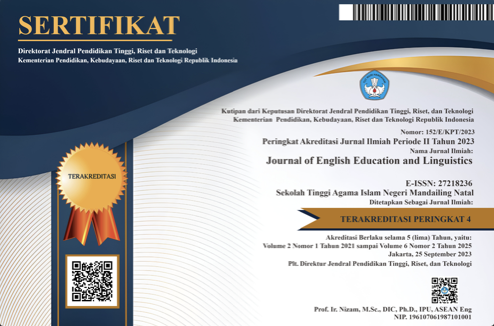IMPLICATION OF LANGUAGE ATTITUDE TO THE LINGUISTIC COMPETENCE OF STUDENTS IN SYNCHRONOUS CLASSES
DOI:
https://doi.org/10.56874/jeel.v3i1.769Keywords:
Implication, Language Attitude, Linguistic Competence, Linguistic Performance, Synchronous ClassesAbstract
Verbal Communication is considered a performance of language. This means that what may have been spoken may also imply a representation of ideologies, constructed realities, and an imitation of life. Language reconnoiters the speaker’s background and points toward the holistic overview of what is seen and felt in real socio-cultural engagements. Through the performance of language, the behavior of it is observed and may imply the proficiency of the student’s fluency in the verbal ability. With this, the researcher conducted an assessment of this linguistic performance in the classroom set-up during the synchronous class to determine the existing language attitude and problematize its sociolinguistic implication of it so that certain measures may be raised to improve the current classroom language management. This is anchored on Noam’s Chomsky’s Theory on Linguistic Performance which is referred to the production and comprehension of language use. Also, the Theory on the Language Attitude by Thomas Hatherley Pear in which he mentioned that sufficient cues for the speaker’s personality are reflected in the assessed linguistic voice used in language. This study conducted is a qualitative study that involved class observation, recording, transcription, analysis, and interpretation in a college English class at the Camarines Sur Polytechnic Colleges. The findings of the study concluded that the attitude of students in English language use involves code-switching and -mixing, language fillers, literacy in technology use, language misuse, and language variety. This identified language attitude implies Linguistic Turn in Academic Conversation and Expressive Language is Linguistic Competence.
References
Alexiadou, A., & Lohndal, T. (2018). Units of Language Mixing: A Cross-Linguistic Perspective. Frontiers in Psychology. Retrieved from https://www.frontiersin.org/articles/10.3389/fpsyg.2018.01719/full#:~:text=Language%2 0mixing%20is%20a%20ubiquitous,they%20adapt%20to%20each%20other.
Cambridge Dictionary. (2022). So. Retrieved from Cambridge University Press: https://dictionary.cambridge.org/us/grammar/british-grammar/so
Coloquit, L. M., Canabal, L., & Paderan, M. P. (2020). Improving Students’ English Writing Proficiency through Interactive Writing Technique. Journal of English Education and Linguistics, 1(1), 72-81. Retrieved from https://jurnal.stain- madina.ac.id/index.php/je2l/article/view/50/72
Communication Community. (2022). What is Expressive Language? Retrieved from Communication Community: https://www.communicationcommunity.com/what-is- expressive-language/
De Vera, P. I. (2020, September 2). Guidelines of teh Implementation of Flexible Learning. Retrieved May 29, 2022, from Commission on Higher Education: https://ched.gov.ph/wp-content/uploads/CMO-No.-4-s.-2020-Guidelines-on-the- Implementation-of-Flexible-Learning.pdf
Dragojevic, M. (2017). Language Attitudes. Oxford University Press. doi:https://doi.org/10.1093/acrefore/9780190228613.013.437
Larasati, A. A., & Simatupang, M. S. (2020). Relationship Between English Language Attitude and. Advances in Social Science, Education and Humanities Research, 509, 63-68. Retrieved from file:///D:/Downloads/125949332.pdf
Martin, F., Parker, M., & Deale, D. (2012). Examining Interactivity in Synchronous Virtual Classrooms. Retrieved from
https://www.irrodl.org/index.php/irrodl/article/view/1174/2253
Matthew, P. (2007). The Concise Oxford Dictionary of Linguistics (@nd Ed.). Oxford: Oxford University Press.
Melander, L., Dalarna, H., & Cunningham, U. (n.d.). Language Attitudes: Evaluational Reactions to Spoken Language. Unpublished Research, 1-28. Retrieved from http://www.diva-portal.org/smash/get/diva2:518098/FULLTEXT01.pdf
Nordquist, R. (2019, July 03). Definitions and Examples of Filler Words. Retrieved May 29, 2022, from https://www.thoughtco.com/what-is-a-filler-word- 1690859#:~:text=%22A%20filler%20word%20is%20an,%2C%20right%2C%20and%20 you%20know.
Nordquist, R. (2019, July 29). Learn the Function of Code Switching as a Linguistic Term. Retrieved May 29, 2022, from ThoughtCo: https://www.thoughtco.com/code-switching- language- 1689858#:~:text=Code%20switching%20(also%20code%2Dswitching,%2Dmixing%20a nd%20style%2Dshifting.
Nordquist, R. (2020, January 23). Definition and Examples of Language Varieties. Retrieved from ThoughtCo: https://www.thoughtco.com/language-variety-sociolinguistics-1691100
Persuad, C. (2021, May 13). Pedagogy: What Educators Need to Know. Retrieved May 29, 2022, from https://tophat.com/blog/pedagogy/
Quin Yow, J., Tan, J. S., & Flynn, S. (2017). Code-Switching as a Marker of Linguistic Competence in Bilingual Children. Bilingualism: Language and Cognition, 1075-1090. Retrieved from https://www.cambridge.org/core/journals/bilingualism-language-and- cognition/article/codeswitching-as-a-marker-of-linguistic-competence-in-bilingual- children/DE93C61F10B151AD5EC248E8D0EB5006
Schnitzler, K., Holzberger, D., & Seidel, T. (2021). All better that being Disengaged: Student Engagement Patters and their Relations to Academic Self-Concept and Achievement. European Journal of Psychology of Education, 627-657.
Shapira, A. (2019, August 26). Why Filler Words Like “Um” and “Ah” Are Actually Useful. Retrieved May 29, 2022, from https://hbr.org/2019/08/why-filler-words-like-um-and-ah- are-actually-useful
Shernof, D. J., Ruzek, E. A., Sannella, A. J., Schorr, R. Y., Sanchez-Wall, L., & Bressler, D. M. (2017). Student Engagement as a General Factor of Classroom Experience: Associations with Student Practices and Educational Outcomes in a University Gateway Course. Frontiers in Psychology, 1-22. doi: 10.3389/fpsyg.2017.00994
Standford University. (2004). Applications of Automata Theory. Retrieved from Standford University: https://cs.stanford.edu/people/eroberts/courses/soco/projects/2004- 05/automata-theory/apps.html#:~:text=Linguistics,a%20finite%20set%20of%20symbols.
Synchronous vs Asynchronous Learning. (2021). Retrieved from eLearners: https://www.elearners.com/education-resources/degrees-and-programs/synchronous-vs- asynchronous- classes/#:~:text=Students%20and%20instructors%20are%20online%20at%20the%20sam e,students%20complete%20their%20work%20on%20their%20own%20time.
Teklesellassie, Y., & Boersma, E. (2018). Attitudes Towards Code-switching in an English- medium Content Classroom. PASAA, 57-77. Retrieved from https://files.eric.ed.gov/fulltext/EJ1191733.pdf
Todor, E.-M., & Degi, Z. (2016). Language Attitudes, Language Learning Experiences and Individual Strategies What Does School Offer and What Does It Lack? Acta Universitatis Sapientiae, Philologica, 8(2), 123-137. Retrieved from file:///D:/Downloads/10.1515_ausp-2016-0022.pdf
Tyson, L. (2006). Critical Theory Today: A User Friendly Guide. London: Routledge.
UTA Libraries. (2022, April 13). Quantitative and Qualitative Research. Retrieved May 29, 2022, from
https://libguides.uta.edu/quantitative_and_qualitative_research/qual#:~:text=Qualitative %20research%20is%20a%20process,in%20their%20every%20day%20lives.
Weitzel, A. (2020, April 6). Course Key. Retrieved from Why Synchronous Courses Are Better Than Asynchronous Courses: https://coursekey.com/synchronous-vs-asynchronous- courses/#:~:text=Synchronous%20courses%20are%20live%20online%20courses%20that %20are,at%20the%20time%20and%20pace%20of%20their%20choosing.
Wilson, C. (2022). Misused, abused and overused words – are you a culprit? Retrieved from StrattonCraig: https://www.strattoncraig.com/insight/misused-abused-overused-words- culprit/
Wolfram, W. (2022). Sociolinguistics. Retrieved from Linguistic Society of America: https://www.linguisticsociety.org/resource/sociolinguistics
Word Connection. (2020, October 6). So, Have You Noticed an Increase in the Use of a Certain Word? Retrieved from Word Connection: https://word-connection.com/excessive-use-of- so/
Zerkina, N., Kostina, N., & Pitina, S. A. (2015). Abbreviation Semantics. Social and Behavioral Sciences, 137-142. Retrieved from https://pdf.sciencedirectassets.com/277811/1-s2.0- S1877042815X00371/1-s2.0-S1877042815045000/main.pdf?X-Amz-Security- Token=IQoJb3JpZ2luX2VjEAgaCXVzLWVhc3QtMSJGMEQCICHRjGYqug1jzHcz1K q36oG5%2FRO%2FPVioys2JKSS%2FiWf3AiAWPgjdfE60Av58zebhFEaE%2BRWY5 o%2FhWumJIl
Downloads
Published
Issue
Section
License
All articles published in the Journal of English Education and Linguistics are licensed under a Creative Commons Attribution-ShareAlike 4.0 International (CC BY-SA) license. This means anyone is free to copy, transform, or redistribute articles for any lawful purpose in any medium, provided they give appropriate attribution to the original author(s) and Journal of English Education and Linguistics, link to the license, indicate if changes were made, and redistribute any derivative work under the same license.
Copyright on articles is retained by the respective author(s) without restrictions. A non-exclusive license is granted to the Journal of English Education and Linguistics to publish the article and identify itself as its original publisher, along with the commercial right to include the article in a hardcopy issue for sale to libraries and individuals.
Although the conditions of the Creative Commons Attribution-ShareAlike 4.0 International (CC BY-SA) license do not apply to authors (as the copyright holder of your article, you have no restrictions on your rights), by submitting to the Journal of English Education and Linguistics, authors recognize the rights of readers and must grant any third party the right to use their articles to the extent provided by the license.

This work is licensed under a Creative Commons Attribution-ShareAlike 4.0 International License.








